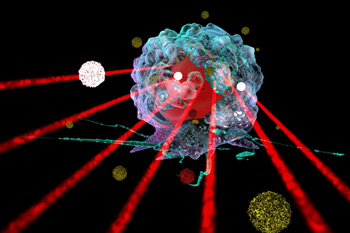Nov 13 2011
Cancer affects about seven million people worldwide, and that number is projected to grow to 15 million by 2020. Most of those patients are treated with chemotherapy and/or radiation, which are often effective but can have debilitating side effects because it's difficult to target tumor tissue.

Nanotechnology, an interdisciplinary research field involving chemistry, engineering, biology, and medicine, has great potential for early detection, accurate diagnosis, and personalized treatment of cancer. Nanoparticles are typically smaller than several hundred nanometers in size, comparable to large biological molecules such as enzymes, receptors, and antibodies. With the size of about one hundred to ten thousand times smaller than human cells, these nanoparticles can offer unprecedented interactions with biomolecules both on the surface of and inside the cells, which may revolutionize cancer diagnosis and treatment.
The development and optimization of near-infrared-absorbing nanoparticles for use as photothermal cancer therapeutic agents has been ongoing. Nanoparticles (35-55nm) provide higher absorption (98% absorption and 2% scattering for gold nanoshells) as well as potentially better tumor penetration. The ability to ablate tumor cells in vitro and efficacy for photothermal cancer therapy clinically tested, and an in vivo model shows significantly increased long-term, tumor-free survival. These nanoparticles have the potential to improve upon photothermal tumor ablation for cancer therapy.
One heat therapy to destroy cancer tumors using nanoparticles is called AuroShell. The AuroShell nanoparticles circulate through a patients bloodstream, exiting where the blood vessels are leaking at the site of cancer tumors. Once the nanoparticles accumulate at the tumor the AuroShell nanoparticles are used to concentrate the heat from infrared light to destroy cancer cells with minimal damage to surrounding healthy cells. Nanobotmodels company provides good visual illustration of this process. Nanospectra Biosciences has developed such a treatment using AuroShell that has been approved for a pilot trial with human patients.
Gold nanoparticles can absorb different frequencies of light, depending on their shape. Rod-shaped particles absorb light at near-infrared frequency; this light heats the rods but passes harmlessly through human tissue. Sphere-shaped nanoparticles absorb laser radiation and passes harmlessly through human tissue too.
Nanobotmodels Company provides a visual illustration of nanoparticle cancer treatment. Their goal - make realistic vision of modern drug delivery technology.